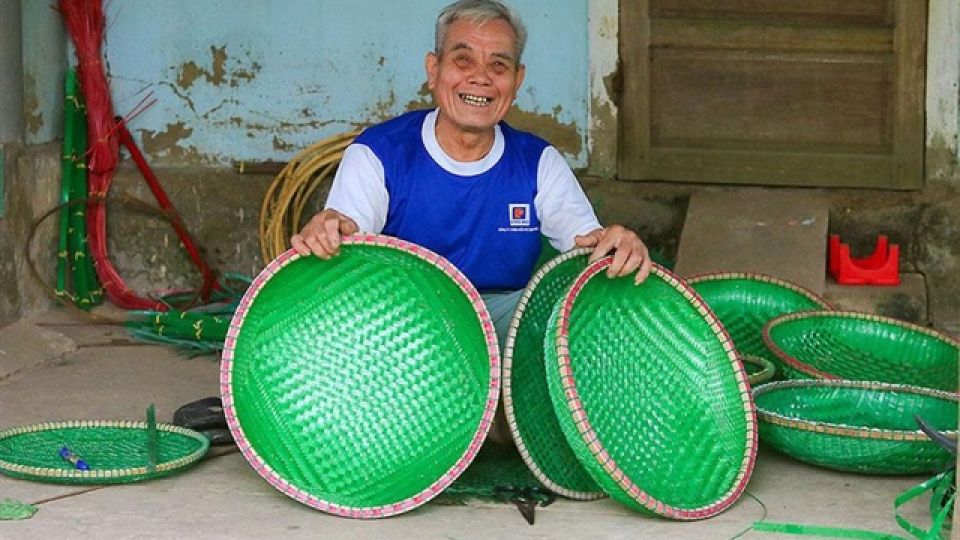May 5, 2022
HANOI — Nguyễn Bá Tụng, 78, spends his time turning plastic waste into useful household items.
Tụng, from Văn Xá Village in the province of Quảng Bình, said making baskets, mats and brooms from plastic waste not only brings in an income but also gives him the joy of contributing to environmental protection.
“The money that I earn from making goods from plastic waste is enough for me and my wife, without depending on support from our children,” he said.
It also helps in reducing plastic waste, which is usually burned or discharged into the environment, causing pollution, he added.
Tụng started using plastic waste to make brooms in 2019, when he saw a lot of plastic ropes, which are used to pack goods, thrown away after use.
“At first, I just collected the plastic ropes to make a broom to clean up my house,” he said.
Then, his daughter asked him to make a basket for her to put vegetables in. It took him about five days to make the basket, he said.
Seeing the basket, some neighbours asked for their own products, he said.
It costs about VNĐ50,000 – 120,000 (US$2-5) for each broom, mat and basket depending on its size, he said.
The products that he makes are cheap and durable, meaning many people made orders, he said.
Nguyễn Văn Hạp, a resident in the commune, told Pháp Luật (Law) online newspaper that: “The basket made from plastic waste by Tụng is very durable. Sometimes, I left it outside in the rain and under the sun, it was not damaged.”
Tụng said the plastic ropes are often thrown away at local building material stores, so, at first, he often went to collect them and used them to make his products.
However, after his made-from-plastic-waste products became known to local people, many local building material stores kept the plastic ropes and called Tụng to come to pick them up, he said.
Lê Thanh Hạnh, chairman of the People’s Committee of the commune, Tụng’s goods are very popular with residents in the commune.
Using discarded plastic to make products not only brings income to Tụng’s family but also raises people’s awareness of environmental protection and plastic waste, Hạnh said.
Plastic waste pollution
According to United Nations Environment Programme, from the 1950s to the 1970s, only a small amount of plastic was produced and as a result, plastic waste was relatively manageable.
However, between the 1970s and the 1990s, plastic waste generation more than tripled, reflecting a similar rise in plastic production.
In the early 2000s, the amount of plastic waste generated rose more in a single decade than it had in the previous 40 years.
Today, we produce about 400 million tonnes of plastic waste every year.
Approximately 36 per cent of all plastics produced are used in packaging, including single-use plastic products for food and beverage containers, approximately 85 per cent of which ends up in landfills or as unregulated waste.
Việt Nam currently ranks fourth in the world for the amount of plastic waste, with approximately 730,000 tonnes of plastic waste going into the sea every year.
The country produces twice the amount of plastic waste as low-income countries.
In response to the situation, in 2019, Việt Nam approved the National Action Plan on Ocean Plastic Waste Management by 2030 with the aim to reduce plastic waste discharged into the sea and ocean by 75 per cent.
The country also wants to totally end the usage of disposable plastic products in coastal tourist attractions and resorts as well as the disposal of fishing gear into the sea by 2030.
A campaign aiming to tackle plastic waste in Việt Nam was launched in January. The campaign, organised by UNDP in co-operation with the Việt Nam Administration of Seas and Islands, will last six months in provinces of Bình Dương, Bình Định, Bình Thuận, Quảng Ninh and Đà Nẵng City.
The organisers will hold conferences on measures to replace or eliminate single-use plastic, develop local tourism in a sustainable way and guidance on the classification of rubbish.


